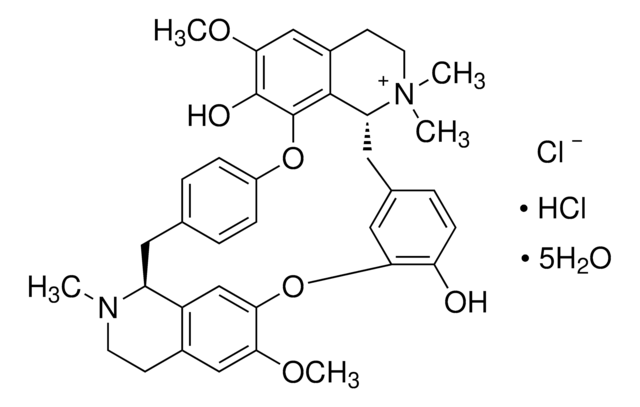This product is soluble in water (1000 mg/mL), in ethanol (20 mg/mL), and in methanol (100 mg/mL).
C4382
Carbamoylcholine chloride
≥98% (titration), crystalline
Sinónimos:
(2-Hydroxyethyl)trimethylammonium chloride carbamate, Carbachol, Carbamylcholine chloride
Seleccione un Tamaño
Seleccione un Tamaño
About This Item
Productos recomendados
Quality Level
assay
≥98% (titration)
form
crystalline
color
white
mp
210 °C (dec.) (lit.)
solubility
H2O: 1 g/mL
ethanol: 20 mg/mL
SMILES string
[Cl-].C[N+](C)(C)CCOC(N)=O
InChI
1S/C6H14N2O2.ClH/c1-8(2,3)4-5-10-6(7)9;/h4-5H2,1-3H3,(H-,7,9);1H
InChI key
AIXAANGOTKPUOY-UHFFFAOYSA-N
Gene Information
human ... CHRM1(1128) , CHRM2(1129) , CHRM3(1131) , CHRM4(1132) , CHRM5(1133) , CHRNA2(1135)
mouse ... Chrm1(12669)
rat ... Chrm1(25229) , Chrm2(81645) , Chrm3(24260) , Chrna2(170945) , Chrna3(25101) , Chrna4(25590)
¿Está buscando productos similares? Visita Guía de comparación de productos
Application
Biochem/physiol Actions
Features and Benefits
signalword
Danger
hcodes
Hazard Classifications
Acute Tox. 2 Oral
Storage Class
6.1A - Combustible acute toxic Cat. 1 and 2 / very toxic hazardous materials
wgk_germany
WGK 3
flash_point_f
Not applicable
flash_point_c
Not applicable
ppe
Eyeshields, Faceshields, Gloves, type P2 (EN 143) respirator cartridges
Elija entre una de las versiones más recientes:
¿Ya tiene este producto?
Encuentre la documentación para los productos que ha comprado recientemente en la Biblioteca de documentos.
Los clientes también vieron
-
How should Carbamoylcholine chloride, Product C4382, be dissolved?
1 answer-
Helpful?
-
-
What is the difference between Carbamoylcholine chloride Products C4382 and C2409?
1 answer-
C4382 (98%) and C2409 (99%) are the same chemical with slightly different purity specifications. Product No. C2409 is no longer available.
Helpful?
-
-
What is the Department of Transportation shipping information for this product?
1 answer-
Transportation information can be found in Section 14 of the product's (M)SDS.To access the shipping information for this material, use the link on the product detail page for the product.
Helpful?
-
Active Filters
Nuestro equipo de científicos tiene experiencia en todas las áreas de investigación: Ciencias de la vida, Ciencia de los materiales, Síntesis química, Cromatografía, Analítica y muchas otras.
Póngase en contacto con el Servicio técnico











